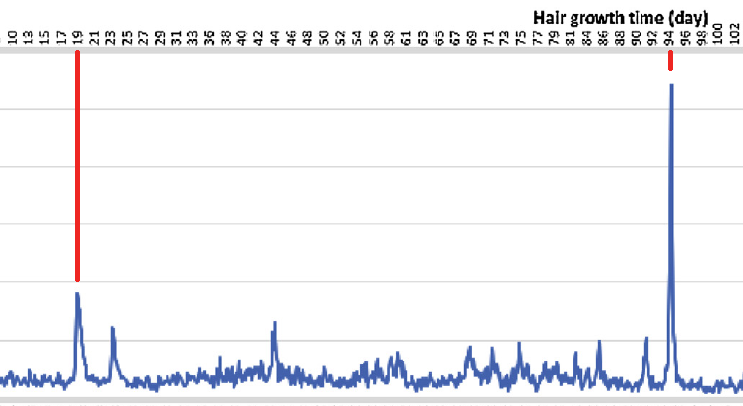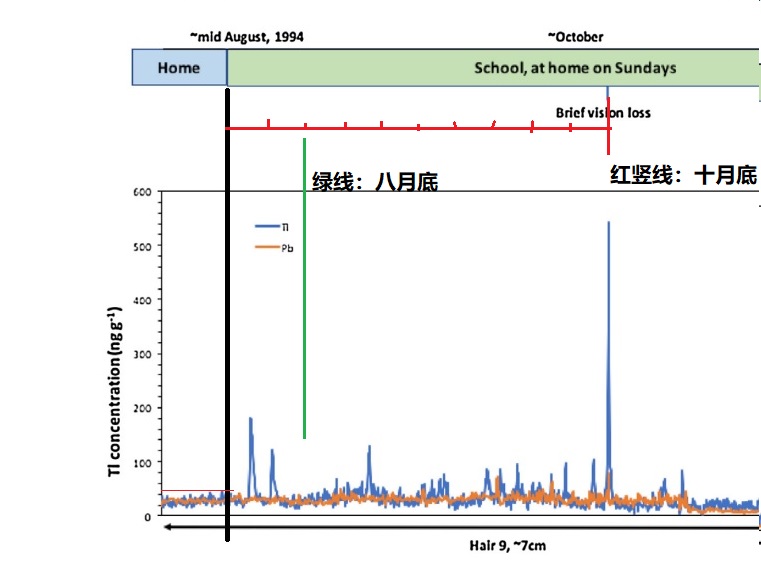- 看看新华社吹捧的数学天才:“主=6”(图) [2024/06]
- 再评《2018年检测朱令头发》:第一个峰值在居家时期 [2023/12]
- 俄杂狗“飞夺泸定桥”谎言的三个相互矛盾版本 [2023/09]
- 评《2018年检测朱令头发》:暑假在家中毒 [2023/12]
- 毛吹牛。武元甲不信,问:"斯大林是否不许过长江?" [2024/01]
- 毛泽东预料的是什么“仁川登陆”? [2016/04]
- 就朱令头发分析给《国际法医》编辑部的信(稿) [2024/01]
- 外蒙独立的几个重要史实 [2016/04]
- 1946年那些事:中国、伊朗 [2024/08]
- 麻省理工去年招15%黑人,但前年只有7.2%。目的何在? [2024/09]
- 毛岸英之死的责任在谁? [2019/03]
- 细扒麻省理工的数字:是黑黄之争还是白黄之争? [2024/09]
- 俄国新书:1946年在人民解放军队伍中的苏联士兵(图) [2016/05]
- 说说宿北战役:中共吹牛奇观——死人复活 [2025/01]
- 黄俄自称“全歼北极熊团”,闹大笑话:北极熊团大半没参战 [2019/01]
- 杜鲁门造谣攻击中国政府的铁证(中国不是伪“中华苏维癌共和国”) [2024/12]
下面是俺给《国际法医》编辑部的信稿。摘译如下。
Ash and He (2018)文中的图2A展示了1994年所收集的受害者一根头发的生长历史。根据该图,头发生长了171天;而根据第4.3节,朱女士“当年年底完全秃顶”(1994年)。根据这些信息很容易计算出:该头发开始生长的第一天是7月14日,而第一个峰值在第19天,即8月2日,受害者当天居家。
但是,该文图五却将峰值日期移至8月下旬受害者从家返校后,与图2A相矛盾。希望通讯作者可以出来解释一下,为什么要不顾与图2的矛盾而把峰值日期后延。
即使以(均值+2×标准差)来计算,也不难得出这根头发从8月9日开始生长的结论,而此时头发的含铊量已经超过正常上限。也就是说,受害者有超过97.8%的可能于8月9日居家时中毒。
已有网友指出:这篇文章的分析还表明,凶手下毒用的是工业铊盐(含铅)而非学校实验室的铊溶液,因为通常学校实验室溶液是纯物质。
下面是原文。
另外补充一点:清华可以查一下当年童爱军实验组的铊溶液是否含铅(这句不在信中)。
A letter to the Editorial Board of "Forensic Science International"
Regarding Richard David Ash and Min He (2018), Details of a thallium poisoning case revealed by single hair analysis
using laser ablation inductively coupled plasma mass spectrometry, Forensic Science International, Vol. 292, 224–231
A 21-year-old Chinese lady, Miss Zhu, was poisoned in 1994.
Figure 2A in Ash and He (2018) provides a scientific presentation for the growth history of a piece of hair from the victim collected in 1994.
According to Figure 2A, the hair grew for 171 days. According to Section 4.3, Miss Zhu was "completely bald at the end of that year" (1994). It can be easily calculated that the first day of that hair started to grow on July 14. That is, based on the information given in Figure 2A and Section 4.3, "Day 1" of ZHU1995H9 (hair ID) is July 14 and Day 171 is December 31.
The first peak is 152 days from the end of the year, and August 1 is 153 days from the end of the year. Therefore the first peak should be on August 2 and the victim was at home that day.
But Figure 5 of the article moves the peak to late August after Miss Zhu returned to school from home. This contradicts with Figure 2A and Section 4.3. The second author who "conducted the interpretation" converted Figure 2A to Figure 5.
Even if we assume the very fast case of 7/ (0.0411 +2*0.0053)=136 (days), we still can conclude that the victim was poisoned at home. It is well known that Miss Zhu lost all her hair on December 23, 1994 when she was hospitalized. With the assumption that the hair growth period be 136 days, the hair started to grow on August 9 when she was at home. It should be noted that she was already poisoned on that day, since the amount of thallium exceeded the safety limit of 10ng/g on Day 1 of the hair [1].
In China, many people accuse Zhu's classmate Miss Sun as the "only suspect". One main reason is that Sun could "legally handle thallium solution" since Sun joined a research group in the school lab starting in September 1994. The above mentioned analyses show that it is very unlikely that Zhu was poisoned only after September 1994.
Another finding from the article by Ash and He (2018) is that Zhu was poisoned with both thallium and lead. On the internet, somebody already pointed out that this shows that the thallium must be from industrial world and could not be from a university lab. Usually, in a school lab, the substance should be pure.
In conclusion, the victim was very likely (with >97.8% chance) to be poisoned at home and the thallium must be from industrial world. The second author for some reason moved the date of the first peak after August 15 and should explain this.
Reference
[1] Queirolo F., Stegen S., Contreras-Ortega C., Ostapczuk P., Queirolo A., Paredes B. Thallium levels and bioaccumulation in environmental samples of Northern Chile: human health risks. J. Chil. Chem. Soc. 2009;54(4):464–469
Regarding Richard David Ash and Min He (2018), Details of a thallium poisoning case revealed by single hair analysis
using laser ablation inductively coupled plasma mass spectrometry, Forensic Science International, Vol. 292, 224–231
A 21-year-old Chinese lady, Miss Zhu, was poisoned in 1994.
Figure 2A in Ash and He (2018) provides a scientific presentation for the growth history of a piece of hair from the victim collected in 1994.
According to Figure 2A, the hair grew for 171 days. According to Section 4.3, Miss Zhu was "completely bald at the end of that year" (1994). It can be easily calculated that the first day of that hair started to grow on July 14. That is, based on the information given in Figure 2A and Section 4.3, "Day 1" of ZHU1995H9 (hair ID) is July 14 and Day 171 is December 31.
The first peak is 152 days from the end of the year, and August 1 is 153 days from the end of the year. Therefore the first peak should be on August 2 and the victim was at home that day.
But Figure 5 of the article moves the peak to late August after Miss Zhu returned to school from home. This contradicts with Figure 2A and Section 4.3. The second author who "conducted the interpretation" converted Figure 2A to Figure 5.
Even if we assume the very fast case of 7/ (0.0411 +2*0.0053)=136 (days), we still can conclude that the victim was poisoned at home. It is well known that Miss Zhu lost all her hair on December 23, 1994 when she was hospitalized. With the assumption that the hair growth period be 136 days, the hair started to grow on August 9 when she was at home. It should be noted that she was already poisoned on that day, since the amount of thallium exceeded the safety limit of 10ng/g on Day 1 of the hair [1].
In China, many people accuse Zhu's classmate Miss Sun as the "only suspect". One main reason is that Sun could "legally handle thallium solution" since Sun joined a research group in the school lab starting in September 1994. The above mentioned analyses show that it is very unlikely that Zhu was poisoned only after September 1994.
Another finding from the article by Ash and He (2018) is that Zhu was poisoned with both thallium and lead. On the internet, somebody already pointed out that this shows that the thallium must be from industrial world and could not be from a university lab. Usually, in a school lab, the substance should be pure.
In conclusion, the victim was very likely (with >97.8% chance) to be poisoned at home and the thallium must be from industrial world. The second author for some reason moved the date of the first peak after August 15 and should explain this.
Reference
[1] Queirolo F., Stegen S., Contreras-Ortega C., Ostapczuk P., Queirolo A., Paredes B. Thallium levels and bioaccumulation in environmental samples of Northern Chile: human health risks. J. Chil. Chem. Soc. 2009;54(4):464–469
附图。
原文图2A:











